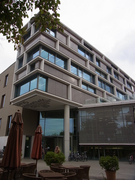RISM at the AIBM Conference
Monday, October 20, 2014

IAML Germany held its annual meeting in beautiful Nuremberg last month. Three members of the RISM Central Office were in attendance. Topics included:
• Data transfers of RISM data • Social Media • RDA • Cultural Program
RISM’s own Gottfried Heinz-Kronberger from RISM Germany in Munich gave a presentation about how the RISM data are used in the Bavarian Union catalog (Bayerischer Verbundkatalog). This allows the RISM records to be used in local catalogs. More about the routine that has been set up and details are available in his PowerPoint presentation. Magda Gerritsen of the Bavarian State Library used RISM data as an example of linked open data being used in libraries. More technical details are in her presentation.
Social media was a topic in the meeting of the Public Libraries interest group. Nobody seems to fully understand Facebook’s secretive, ever-changing news feed algorithm, but Martin Kramer from the Mediothek Krefeld (Facebook page, Seniorbook page) told us that different kinds of posts have different values. Posts with the highest values will stay near the top of your users’ news feeds (or show up in the first place). The types of posts ranked from most to least valuable are:
• Videos uploaded on Facebook
• Pictures uploaded on Facebook with text
• Link with text
• Text only
Therefore, posting text only has the least amount of impact on your Facebook fans.
Manfred Ullrich of the Stadtbücherei Würzburg (Facebook page) gave us tips on how to engage our audience, such as posing questions, introducing members of the staff, and showing that we are still available even during busy times (such as a move). He also showed us how easy it is to latch onto social media trends and even create new series, such as the #klangbibliothek on Instagram. At the end of his presentation, Manfred called all librarians to contribute to IAML’s Facebook page, with which I can only agree.
On the last day, there were several presentations about the current state of RDA implementation in Germany. Renate Behrens of the German National Library gave us an overview of the transition to RDA and showed us the timeline: all name authority files are already being created using RDA, and next year new bibliographic records will be created using RDA. Wibke Weigand and Martina Rommel gave us helpful examples of what RDA records look like and what controlled vocabulary to use. We heard that training will be provided in the form of documentation and workshops next year. In addition, access to the RDA Toolkit is available free of charge to any German institution through your library association or from the German National Library.
Our host, the Nuremberg Public Library (Stadtbibliothek Nürnberg, RISM siglum: D-Nst), gave two guided tours as part of the cultural program of the AIBM conference. The first tour was through the wonderful exhibit featuring Georg Andreas Will’s Bibliotheca Norica (“Die Bibliotheca Norica des Georg Andreas Will als Erbe und Aufgabe”) and was very inspiring and informative. Using documents, personal writings, and a broad sense of the word “Norica” (items relating to Nuremberg), the exhibit showed different types of treatments used by preservationists at the library. Each item in the collection received a custom-made enclosure made of corrugated board. Binding and paper restoration was undertaken on an individual basis. The historical Bibliotheca Norica Williana is of great importance for the geography of Nuremberg.
The second tour through the library took us through the individual departments. The fantastic new building has been open since 2012 and is integrated into the neighboring medieval convent (Katharinenkloster). We admired the walk from the new section to the old through a cloister filled with greenery and a newspaper café. The building’s architecture won us over through being open toward the outdoors and having a splendid panorama view of Nuremberg Castle. Our colleagues at the library gave us an expert presentation of their operations and created a collegial atmosphere from beginning to end. The Music Library was of course of special interest to those of us on the tour. The arrangement of the materials in movable bookshelves gave the area a contemporary feel. The shelving can be moved aside when needed during events at the library. New acquisitions are often initiated by patrons’ wishes. In addition, the library fulfills its commitment to education. Every type of format can be found in the library. The patron base is the widest that the library can have: people of all generations, levels of education, and nationalities in Nuremberg take advantage of the library’s services. The multicultural nature of the city is also reflected in the foreign-language book selection. A paradise for readers.
AIBM member Manfred Ullrich took lovely pictures of Nuremberg and the conference and can be seen on Flickr (part 1) (part 2).
Photo (c) Brett Sterly.
Share Tweet EmailCatégorie: Evénements

